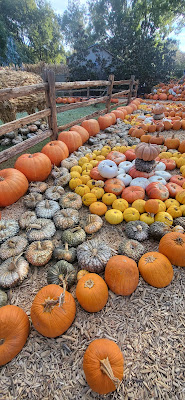Oooooh, my favorite time of the year also means a trip to Autumn at the Arboretum. Come along with me and just enjoy the eye candy - it's so beautiful.
This year, the theme is Texas Town.
The Western Diamond Rattlesnake is a formidable snake with distinctive features including a heavy body, triangular head, and dark diamond-shaped patterns along its back. As a pit viper, it possesses specialized heat-sensing pits behind each nostril, aiding in prey detection. Found across the southwestern United States and Norther Mexico, it thrives in various habitats, from deserts to forests. Feeding on a diet of small animals, it faces threats from both predators and humans. Despite its feared reputation, it plays a vital role in its ecosystem. With a lifespan of 15-20 years, reaching sizes of 3-7 feet, it's a fascinating creature marked by its unique rattle, composed of keratin segments that grow with each shed.
Sod houses, appearing in Texas in the mid-19th century, offered a practical solution for settlers in areas with limited timber. Constructed by stacking layers of sod, these homes had thick walls that provided excellent insulation, keeping the interior temperature stable year-round despite Texas's harsh climate.
Nine-Banded Armadillo - About the size of a small dog, armadillos live throughout Texas, except in the Trans-Pecos. Their bony shell acts like armor and provides protects from predators. Armadillos have powerful claws for digging up meals, mostly insects and their larvae. They also dig burrows in which to den.
Saloons were prominent features of pioneer towns, often characterized by wooden facades and swinging saloon doors. They emerged in Texas during the mid-19th century, providing places of entertainment, social gathering, and refreshment. Many saloons featured thematic decor with wild west and cowboy-themed elements, creating an atmosphere that appealed to both settlers and travelers.
Inside -
Inside -
Love the bonnets hanging from the ceiling.
General Stores, with their wooden facades and display windows, became prevalent in Texas during the 19th century as trading posts and centers of commerce. These stores provided settlers with access to essential supplies and goods. They often functioned as community hubs where residents could catch up on local news and engage in social interactions while shopping for necessities. General Stores were preceded by Trading Posts, which were scattered across the frontier, often located in areas where settlers were establishing communities or where trails and trade routes intersected. These trading posts were crucial for facilitating trade between settlers, Native Americans, and sometimes travelers passing through the region.
On the frontier, survival often hinged on access to water. Before the advent of windmills, settlers faced the arduous task of hauling water across vast prairies. The introduction of cisterns revolutionized farm life, providing a reliable water source crucial for survival on the land. Cisterns ensured precious water wasn't lost to the soil. Despite the hardships of pioneer life, the refreshing water drawn from cisterns provided relief for hard-working plains people, offering a cool relief after hard days in the heat. These humble structures not only preserved life, but also became symbols of resilience and ingenuity in the face of adversity.
Farmhouses began to appear in Texas during the mid-to-late 19th century as pioneer families grew and established themselves. These homes featured multiple rooms and central hallways, often with cable roofs and covered porches. The farmhouse served as center of family life and hospitality. Ranches and ranch houses began to appear in Texas as the state's cattle industry expanded during the mid-19th century. These structures were often situated near rivers, providing access to water for livestock. Texas Longhorn cattle, iconic in the state's ranching history, were often herded on these vast ranches.
The history of cowboy boos reflects their evolution from essential riding gear to iconic fashion statements. Originally crafter for practicality from cowhide leather, cowboy boots ranged from sturdy work boots to ornate fashion pieces made from exotic materials like ostrich or alligator. Inspired by vaquero-style boots from Spain, cowboy boots emerged in the plains and deserts of the Midwest and Western United States in the 1800s. Designed with tall shafts for leg protection and angled heels for secure stirrup placement, they became synonymous with cowboy culture. Following the decline of military-style Wellington Boots after the American Civil War, cowboy boots surged in popularity among pioneers and cattle herders in the west. With industrialization, manufacturing processes improved, leading to mass production and the establishment of enduring boot companies in Texas and Kansas. The design evolved to include variations like Roper Boots for rodeo activities, while toe shapes shifted from rounded or squared to narrow points, influenced by western movie trends in the 1940s.
One-room schoolhouses emerged in Texas during the 19th century, providing educational opportunities for pioneer children. These simple wooden structures often had gable roofs and multiple windows for natural light. One-room schoolhouses were not only places of learning but also served as community gathering spaces for meetings and social events.
One last item in this area - hmmmm. Moving on.
Time for a selfie - I like this one.





















































No comments:
Post a Comment